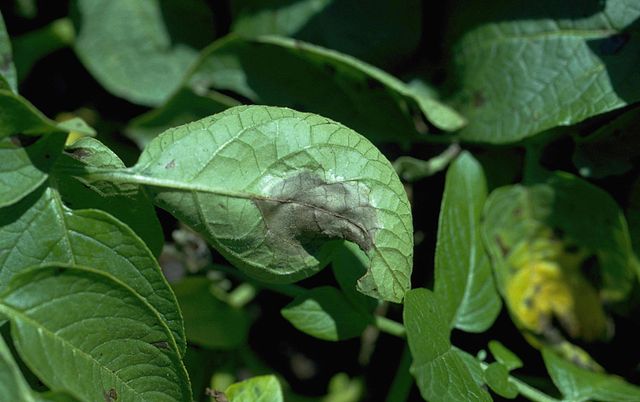Introduction
Late blight is a serious fungal disease of tomato and potato plants. It is caused by the pathogen Phytophthora infestans. The pathogen was first described by Miles Joseph Berkeley, one of the founders of plant pathology. It was assigned the name Phytophthora infestans by Henrich Anton de Bary, a German surgeon and botanist. Late blight caused the Irish Potato Famine of the 1840s. It can severely limit crop yield, and affects the entirety of infected plants.
Distribution & Habitat
Late blight occurs throughout the United States, wherever susceptible plants are present.
Hosts
Late blight primarily infects potato and tomato plants. Eggplants are also vulnerable to infection, as well as several weeds and ornamental plants in the Solanaceae family, including black nightshade and hairy nightshade. Plants that have been weakened by environmental stressors or insect infestations are more vulnerable to infection.
Disease Cycle
The late blight pathogen survives in the form of mycelium in infected tubers, seedlings, or tomato fruit. In spring, when conditions are sufficiently damp, the pathogen produces sporangia or sac-like structures on sporangiophores, stalk-like structures that form on the surface of infected plant material. The sac-like structures expel asexual spores, which are disseminated by splashes of rain, air currents, insect vectors, and pruning tools to healthy plant foliage, which they readily infect. When conditions are cool and wet, asexual zoospores will emerge from the sporangia after a few hours. The zoospores swim on the surface of the host plant for a few hours, before penetrating into the plant tissue, and infecting it. The ensuing white sporulation occurs at the margins of the lesions on the lower surface of the leaves. Late blight infections may occur at any point during the growing season.
Symptoms of Infection
Late blight can be identified by black or brown lesions that form on the leaves and stems of affected plants. The lesions are initially small, and appear water-soaked. They may sometimes have chlorotic borders. The lesions rapidly expand, until the entire leaf has become necrotic. Potato tubers can be become infected when the pathogen enters into the soil. Infected tuber tissues are copper brown, red, or purple in color. Tubers suffering from late blight infection are often subsequently invaded by a soft rot bacteria that reduces the plant to pungent, rotten mass. On tomato plants, late blight infections cause the formation of dark brown, firm lesions that are followed by soft rot, and disintegration. The infectious spores may be visible drifting in the air during humid weather.
Management
- When conditions are dry, the incidence of late blight infection is reduced considerably.
- Foliar fungicide sprays can be employed to combat the disease. Coat the leaves thoroughly to prevent late blight infection. Fungicidal sprays must be applied prior to exposure to the pathogen.
- Transgenic potatoes have been developed that were modified with genes from wild Solanum species, rendering them less prone to infection.
- Avoid planting crops in fields bordered by forests.
- Practice crop rotation every two to three years to prevent the pathogen from becoming established in an area. Select plants that are resistant to late blight infection.
- Cull infected plants and tubers.
- Avoid excessive nitrogen fertilization, as it can delay plant maturity, promote insect infestations, and reduce crop yield.
Photo courtesy of Howard F. Schwartz, Colorado State University, United States CC-by-3.0


